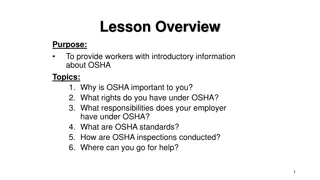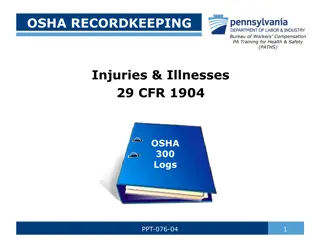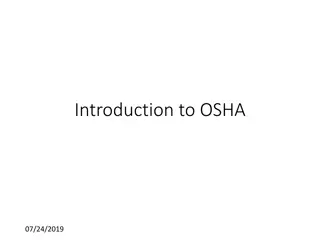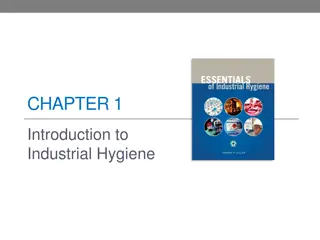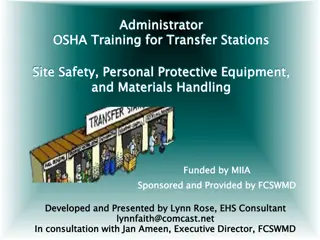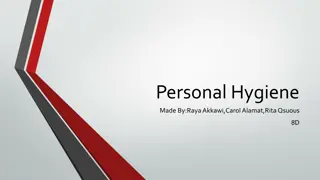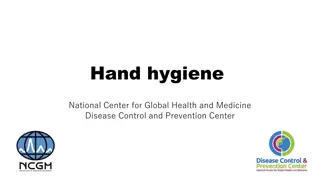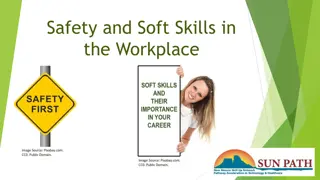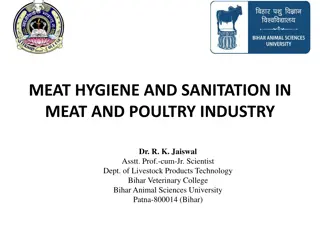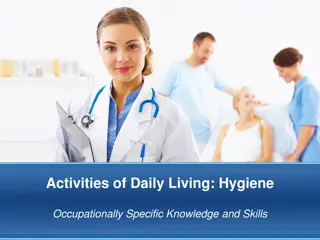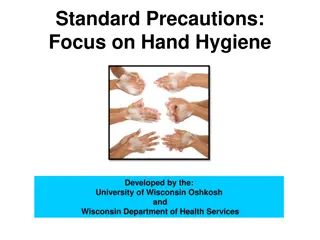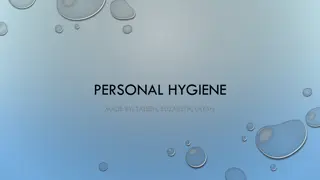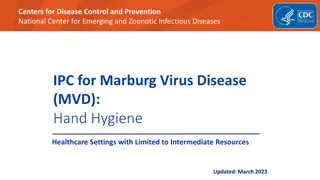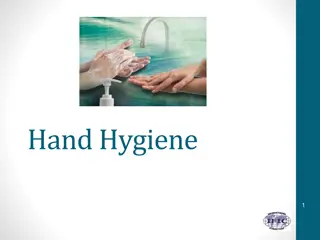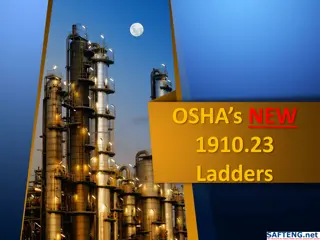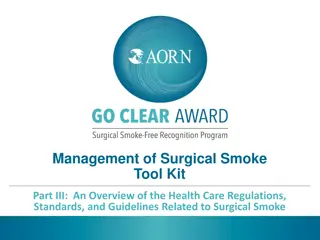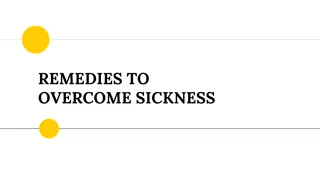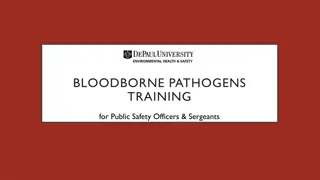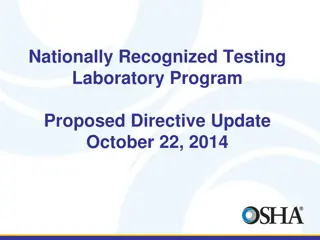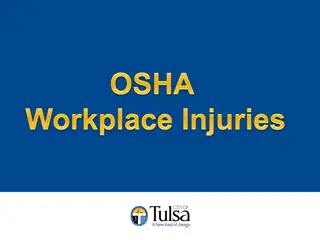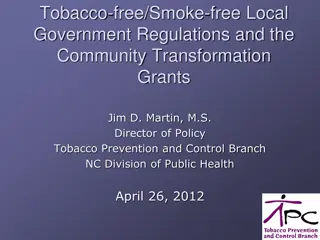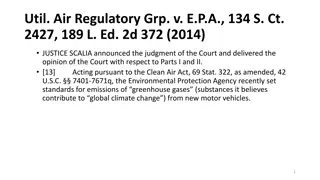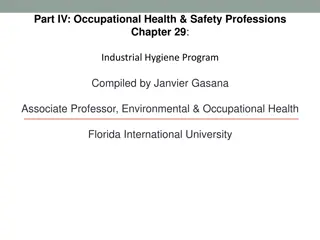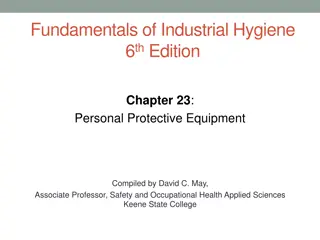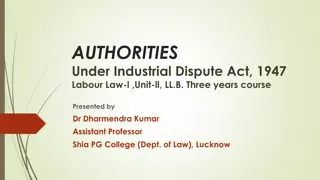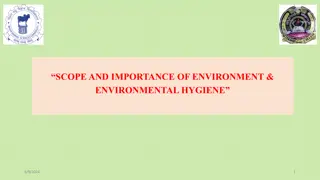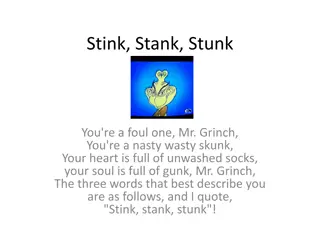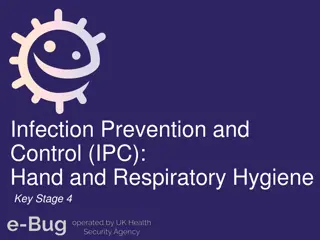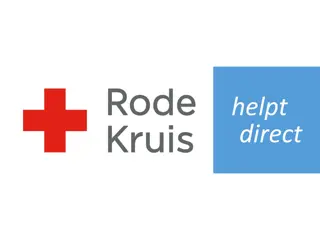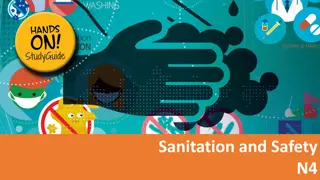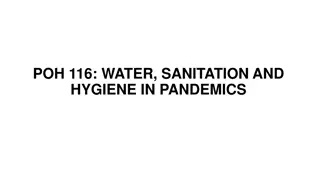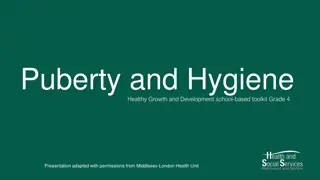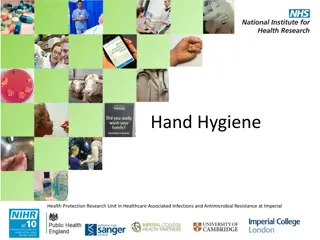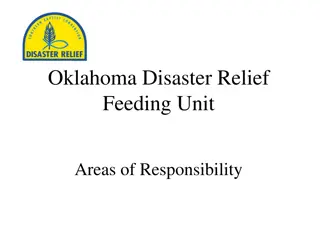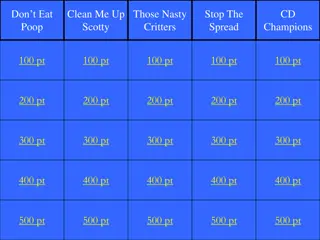Overview of OSHA Act and Government Regulations in Industrial Hygiene
The OSHAct of 1970 aims to ensure safe working conditions and protect human resources. Key provisions empower the Secretary of Labor to issue standards and investigate violations. Employers and employees have specific duties outlined in the Act. OSHA coverage includes private sector employees, while some groups like State/municipal workers have occasional Congressional interest in their coverage.
Download Presentation

Please find below an Image/Link to download the presentation.
The content on the website is provided AS IS for your information and personal use only. It may not be sold, licensed, or shared on other websites without obtaining consent from the author. Download presentation by click this link. If you encounter any issues during the download, it is possible that the publisher has removed the file from their server.
E N D
Presentation Transcript
Fundamentals of Industrial Hygiene 6thEdition Part VII: Government Regulations and Their Impact Chapter 30: Government Regulations Compiled by David C. May, Associate Professor, Safety and Occupational Health Applied Sciences Keene State College
The OSHAct to assure so far as possible every working man and woman in the Nation safe and healthful working conditions and to preserve our human resources. OSHA Act of 1970"
Key Provisions Empower the Sec. of Labor to issue safety and health standards Procedures for investigating violations at employer worksites, including interview of employees, use of walk-around representatives issue monetary penalties require certain recordkeeping
Key Provisions Provide up to 50/50 funding of states that wish to establish a program at least as effective as the federal OSHA program (State Plans) Provide funds to state governments and other entities to conduct on-site consultations for employers upon request
Duties in the Act General duty provision (section 5 (a)(1)) Each employer shall furnish to each of his employees employment and a place of employment which are free from recognized hazards that are causing or are likely to cause death or serious physical harm to his employees.
Duties in the Act (cont.) 5(a)(2) Each employer shall comply with occupational safety and health standards promulgated under this Act.
Duties in the Act (cont.) 5(b) Each employee shall comply with occupational safety and health standards and all rules, regulations, and orders issued pursuant to this Act which are applicable to his own actions and conduct.
OSHA Coverage Private sector employees Federal employees Not Covered State/municipal workers (subject of occasional Congressional interest) although OSHA requires it of State-Plan States Self-employed Workers covered by other agencies claiming safety and health coverage
State Plans State Plan States and Federal OSHA
OSHA Standards Specification standards explicit details, construction/design Performance standards broad objective, flexible implementation
OSHA Standards (cont.) Vertical standards apply to a particular industry Horizontal standards apply to any industry where the hazard exists.
Standards Adoption OSHA was given the authority to adopt consensus standards or existing federal standards for the first two years (1971 & 1972) Sources included American Standards Association (now American National Standards Institute, or ANSI) Walsh-Healy Act Public Law 91-54 of 1969 (Construction Safety Act) Service Contract Act of 1965
Rulemaking Milestones (after 1971) Advanced notice of proposed rulemaking Proposed rule Final rule Challenges to rule U.S. Court of Appeals (affected parties) Congressional disapproval
Inspections Without advanced notice (normally) Conducted by OSHA compliance safety and health officers (trained in safety and/or industrial hygiene) Source: OSHA
Inspection Priority Imminent danger Fatality/catastrophes Complaints/Referrals Programmed inspections 1. 2. 3. 4.
Unprogrammed Activity Imminent danger Fatality /catastrophes Emergency Response Complaints/Referrals Whistleblower Complaints Follow-ups and Monitoring
Programmed Inspections Site-Specific Targeting (SST) Program Construction Inspections Special Emphasis Programs (SEPs) Sever Violator Enforcement Program (SVEP) Special Emphasis Program on Trenching and Excavation: Quick action by the OSHA inspector prevents possible death from this trench cave-in Source: OSHA
Inspection Procedures Arrival and introduction (unannounced) Opening conference compulsory process if necessary (1903.4) ex parte application no waivers review inspection procedures review safety and health records
Inspection Procedures (cont.) Walk through, interviews with employees Sampling (industrial hygiene inspections) Evaluation of safety and health program Closing conference discuss apparent violations and abatement
Citations Standard violated Abatement dates can be adjusted by a Petition to Modify an Abatement date (PMA) Penalties Source: OSHA
ViolationsTypes Other-than-serious Serious Willful Repeat Failure-to-Abate
General Duty Clause Violations 1) The employer failed to keep the workplace free of a hazard to which employees of that employer were exposed. 2) The hazard was recognized. 3) The hazard was causing or was likely to cause death or serious physical harm 4) There was a feasible and useful method to correct the hazard
Issuance of citation Employer decision Accept findings Request informal conference Notice of contest (within 15 working days) OSHRC (independent commission) hearing Commission (on appeal) U.S. Court of Appeals Supreme Court
Employer Responsibilities Find and correct hazards following all relevant OSHA standards Notify OSHA of fatalities and/or catastrophes (i.e., three or more workers hospitalized) within 8 hours
Employer Responsibilities (cont.) Inform and train employees Provide necessary PPE Post citations and OSHA Job Safety and Health Poster
Employee Rights Employees can not be discriminated for: asking OSHA to inspect their workplace or participating in the inspection participating in safety and health activities Workers have the right to receive information about hazards in their workplace get copies of test results (hygiene sampling) their medical record OSHA injury and illness log of their workplace
OSHA Whistleblower Program Covers Occupational Safety and Health Act Surface Transportation Assistance Act Asbestos Hazard Emergency Response Act International Safe Container Act Clean Air Act Comprehensive Environ. Response, Compensation and Liability Act Energy Reorganization Act Federal Water Pollution Control Act Pipeline Safety Improvement Act Safe Drinking Water Act Sarbanes-Oxley Act Solid Waste Disposal Act Toxic Substances Control Act Wendell H. Ford Aviation Investment and Reform Act for the 21st Century The Federal Rail Safety Act (FRSA) National Transit Systems Security Act (NTSSA) Consumer product safety Improvement Act Affordable Care Act (ACA) Dodd-Frank Wall Street Reform and Consumer Protection Act of 2010 Seaman s Protection Act FDA Food Safety Moderation Act (FSMA)
Compliance Assistance and Resources Compliance Assistance Specialist OSHA Training Institute and Educational Centers OSHA Website (www.osha.gov) Consultation program (free on-site) Voluntary Protection Programs (VPP)
National Institute for Occupational Safety and Health (NIOSH) Established by OSHAct (part of HHS) Supports occupational safety and health research in academic centers Responsible for identifying occupational safety and health hazards and control recommendations
NIOSH Responsibilities Training NIOSH Education and Research Centers (ERCs) Makes recommendations to OSHA and MSHA Certifies Respirators (technical design review and tests)
NIOSH Initiatives National Occupational Research Agenda Establishes national OS&H priorities Research-to-Practice (r2p) Prevention through Design
NIOSH Initiatives Total Worker Health Health Hazard Evaluation Program Conducts non-enforcement workplace health hazard assessments upon request, publishes findings
NIOSH Publications NIOSH Pocket Guide to Chemical Hazards Current Intelligence Bulletins and Alerts NIOSH Manual of Analytical Methods methods for sampling and analysis of contaminants in workplace air and in the blood and urine of workers
Other Regulatory Agencies Mine Safety and Health Administration Periodic inspection of mines, investigate mine accidents, develop mine standards Environmental Protection Agency Toxic Substances Control Act PCBs, Asbestos (schools), Radon, Lead (residential) Resource Conservation and Recovery Act Solid waste Cradle to grave approach Comprehensive Environmental Response, Compensation, and Liability Act (CERCLA) Super Fund Worker Protection Standard for Agricultural Pesticides (pesticide safety standards) Training, field reentry time Indoor Air Quality Research and Education


